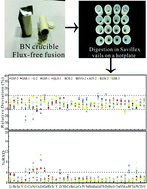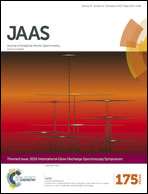Flux-free fusion technique using a boron nitride vessel and rapid acid digestion for determination of trace elements by ICP-MS†
Abstract
In this study, we present a new method for the dissolution of silicate rocks by flux-free fusion using a boron nitride vessel in preparation for analysis of bulk rock trace elements; this method is especially applicable to felsic intrusive rocks. The method was evaluated by analyzing five intrusive rocks (GSP-2, GSP-1, G-2, GSR-1 and QLO-1) and five extrusive rocks (AGV-2, BCR-2, BHVO-2, GSR-3 and RGM-2). The optimum conditions for the fusion of intrusive rocks were determined to be heating at 1600 °C for 1 min, which is effective to break up strong Si–O bonds. The fused glasses were dissolved using HF/HNO3 acids in closed screw-top Savillex vials on a hotplate; no high-pressure PTFE digestion bomb was required. Zr and Hf were completely recovered from the granodiorite GSP-2 reference material in 6 hours at 150 °C, which was 8 times faster than the method using a conventional high-pressure PTFE digestion bomb at 190 °C. The precision (RSD%, 1 s) of the elemental determinations in nearly 92% of the analyzed samples was better than 4%. Replicate analyses (n = 3) of the reference materials indicated that most of the results agreed with the reference values within a relative error of <10%. Additionally, the flux-free fusion retained all the materials in solution and was valid for volatile elements.



 Please wait while we load your content...
Please wait while we load your content...